A few days ago the last of the hexagonal primary mirrors snapped into place, moving from its launch position. https://blogs.nasa.gov/webb/2022/01/19/webb-mirror-segment-deployments-complete/. The Webb telescope has now completed the main phases of its operational deployment. What a relief to all those involved in risk management of this venture.

While there is a way to go before the telescope mirrors are fully aligned and operational, the deployment will be a relief to everyone on the NASA team.
As an observer of the development process I’ve been eager to see it reach this stage. I’m also keen to see the scientific benefits from the telescope’s ability to peer far back into the early stages of the cosmos.
Risk management with 344 single point failures
To fit within the launch fairing, NASA designed the Webb telescope to be launched like a folded up origami, then deployed itself when out in space. https://www.youtube.com/watch?v=RzGLKQ7_KZQ
NASA tweeted that the deployment has 344 single point failures, including wires, motors, pulleys and release mechanisms. https://twitter.com/nasawebb/status/1478412564983959553?lang=en
As a risk manager, 344 single point failures is a very large number in an unforgiving environment. To put it in context, landing on Mars is very challenging with only around half of all attempts having been successful. That has only 100 single point failures. https://blogs.nasa.gov/drthomasz/2021/08/02/launching-the-worlds-biggest-space-telescope/
If any one of the single point failure mechanisms was faulty, then it could jeopardise successful deployment and operation.
And the mechanisms needed to operate successfully in space where temperatures ranged from plus 50 degrees celsius on the sunlit side down to below -200 celsius on the shaded side. It’s easy for me to imagine something jamming with such wide thermal differences.
A third factor is that there is no likely repair mission. Webb’s predecessor, the Hubble telescope, which has been serviced in near-Earth orbit many times. Whereas, NASA is sending Webb far away, to the L2 Lagrange point where it can get the best operational view of the heavens.
Knowing the challenges helps make sense of the extensive testing that the telescope underwent prior to launch. https://m.facebook.com/SeekerMedia/videos/10155711515468387/
Test and learn as a risk management approach
It was frustrating to watch the telescope crawl through what seemed like years-long COVID-delayed testing programmes. But what we didn’t hear about is all the little learnings and changes that were made along the way to make deployment more reliable.
As it turns out – all of the deployment mechanisms worked perfectly after launch. That’s a tribute to a strong risk management programme. It’s also a risk approach that is well-suited to a politically backed enterprise such as NASA that doesn’t have the licence to fail frequently and learn.
Comparison to SpaceX approach
Another approach is to build lots of test articles, to try them out and to learn quickly. This approach is exemplified by the SpaceX series of exploding rockets. https://www.youtube.com/watch?v=bAhhtRgIC-E
SpaceX learns from test launches of partially built articles, which destroyed many rockets but progresses quickly. NASA had only Webb has one telescope and learns from extensive tests prior to launch which is outwardly a much slower process. A commonality is that they will both have very strong cultures of learning and applying the learnings.
Launching future large space telescopes
NASA, the European Space Agency and other partners are planning to launch an exciting range of new space telescopes slated for development and launch over the next decade. Just because the Webb deployment has been successful, it doesn’t mean it’s easy or should be replicated.
I’d like to think that future large space telescope deployments will utilise the new 10m diameter launch vehicle that SpaceX is developing and testing. That could avoid the need for so much folding, eliminating many of the single point failures.
Now that would be good risk management.
About the Author – Kevin Oldham
Kevin Oldham is a director of Navigatus with a depth of experience in helping clients to achieve success in an uncertain context. A brief profile for Kevin can be found here.

Comments
No comments yet.